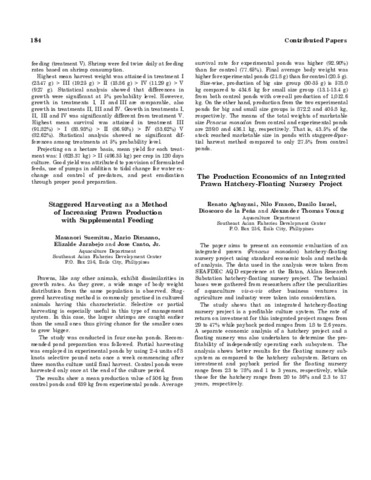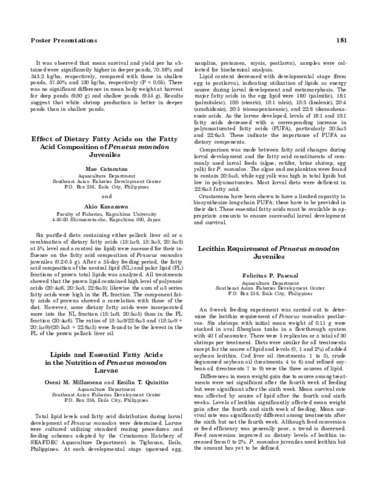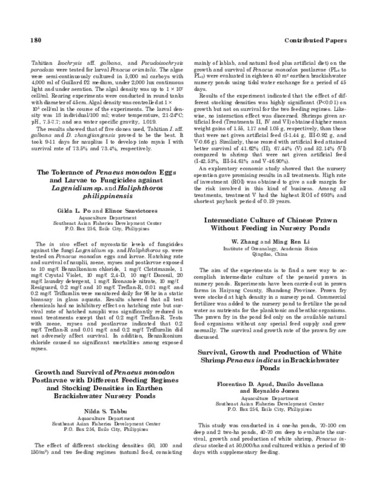Effect of salinity on the osmotic, chloride, total protein and calcium concentrations in the hemolymph of the prawn Peneaus monodon (Fabricius)
- Global styles
- MLA
- Vancouver
- Elsevier - Harvard
- APA
- Help

View/
Date
1986Page views
2,392ASFA keyword
AGROVOC keyword
Taxonomic term
Metadata
Show full item record
Share
Abstract
1. Osmolality and chloride concentrations in the hemolymph of Penaeus monodon became stable 1 day after molting in 32 ppt, while total protein and calcium concentrations remained stable throughout the molting cycle. When intermolt (≥ 36 hr postmolt) animals were transferred from control (32 ppt) to experimental (8–40 ppt) salinities, osmolality, chloride and total protein, but not calcium, concentrations in the hemolymph achieved steady state values 24–48 hr after transfer.
2. The hemolymph osmolality was a linear function (slope = 0.28) of medium osmolality at salinities between 8 and 40 ppt. It was isosmotic to seawater at 698 mOsm (10 g prawns) and 752 mOsm (30 g), and was hyperosmotic to the medium below isosmotic concentrations, and hypoosmotic to those above.
3. Hemolymph chloride concentration was isoionic to seawater at 334 mM, and was hyperregulated below isoionic concentrations, and hyporegulated to those above.
4. P. monodon maintained its hemolymph calcium concentration between 6.4 and 10 mM when medium salinities increased from 8 to 40 ppt.
5. Total protein concentration in the hemolymph was independent of medium salinity (8–40 ppt) and hemolymph osmolality (540–850 mOsm).
Description
SEAFDEC Aquaculture Department Contribution No. 159.
Suggested Citation
Ferraris, R. P., Parado-Estepa, F. D., Ladja, J. M., & de Jesus, E. G. (1986). Effect of salinity on the osmotic, chloride, total protein and calcium concentrations in the hemolymph of the prawn Peneaus monodon (Fabricius). Comparative Biochemistry and Physiology - Part A: Physiology , 83(4), 701-708. https://doi.org/10.1016/0300-9629(86)90713-9
Type
ArticleISSN
0300-9629Collections
- Journal Articles [1258]
Related items
Showing items related by title, author, creator and subject.
-
Staggered harvesting as a method of increasing prawn production with supplemental feeding
Suemitsu, M.; Dimaano, M.; Jarabejo, E.; Canto, J. Jr. (Aquaculture Department, Southeast Asian Fisheries Development Center, 1985)Prawns, like any other animals, exhibit dissimilarities in growth rates. As they grow, a wide range of body weight distribution from the same population is observed. Staggered harvesting method is commonly practised in ... -
Lipids and essential fatty acids in the nutrition of Penaeus monodon larvae
Millamena, O.M.; Quinitio, E.T. (Aquaculture Department, Southeast Asian Fisheries Development Center, 1985)Total lipid levels and fatty acid distribution during larval development of Penaeus monodon were determined. Larvae were cultured utilizing standard rearing procedures and feeding schemes adopted by the Crustacean Hatchery ... -
The tolerance of Penaeus monodon eggs and larvae to fungicides against Lagenidium sp. and Haliphthoros philippinensis
Po, G.L.; Sanvictores, E. (Aquaculture Department, Southeast Asian Fisheries Development Center, 1985)The in vivo effect of mycostatic levels of fungicides against the fungi Lagenidium sp. and Haliphthoros sp. were tested on Penaeus monodon eggs and larvae. Hatching rate and survival of nauplii, zoeae, myses and postlarvae ...





